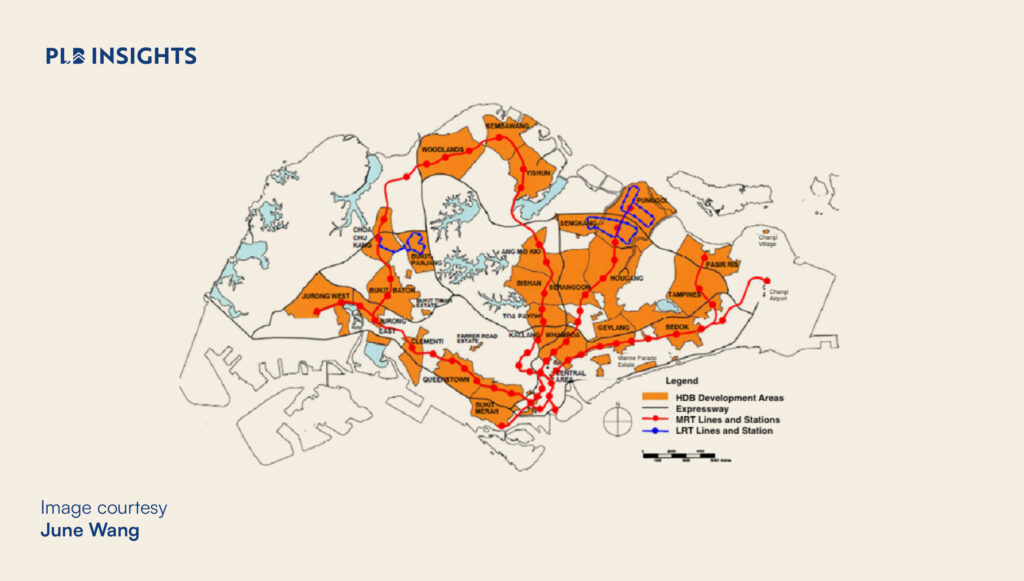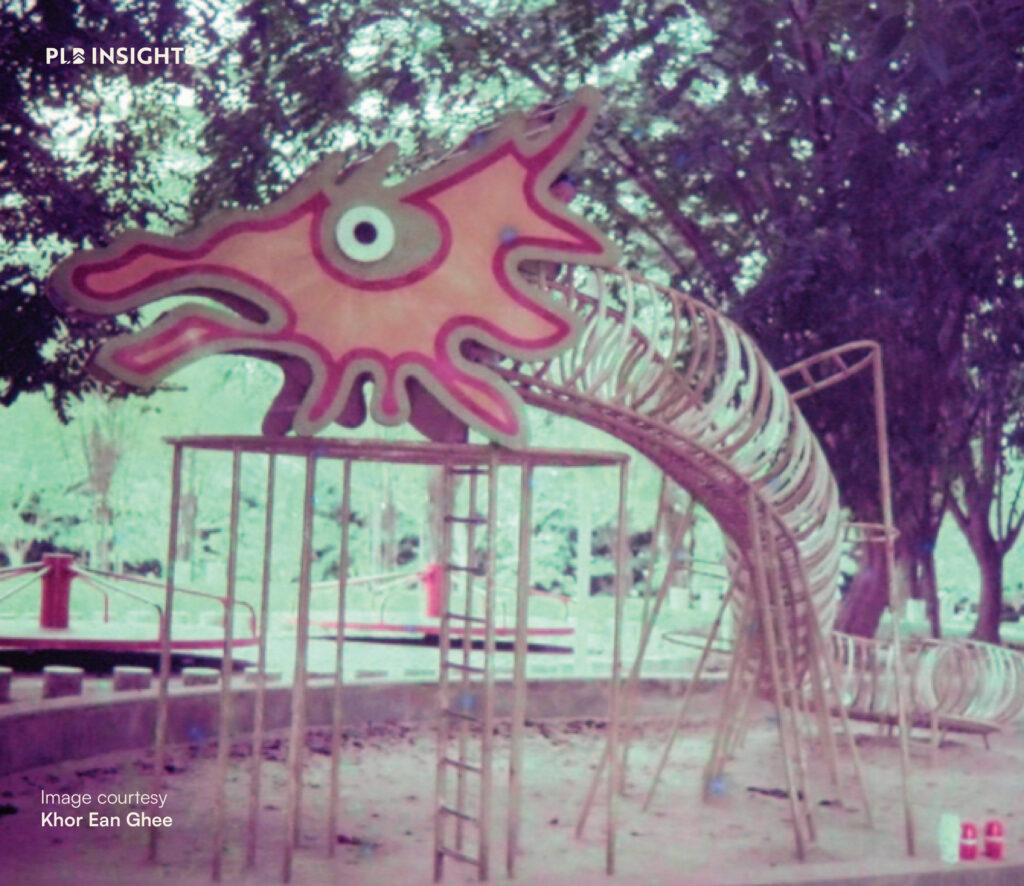
Symbolising strength, good fortune, and boundless possibilities, dragons hold a special place in Chinese culture, especially during the joyous celebration of Chinese New Year. In this festive special, we delve into the dragon-inspired playgrounds designed by the visionary Khor Ean Ghee. These were not just play spaces; they were vibrant canvases of cultural narratives, weaving together the tales of childhood adventures against the backdrop of Singapore’s burgeoning urban landscape.
Our exploration extends back to the bustling 1970s, an era marked not only by the emergence of new towns and housing estates but also by the creation of communal spaces that mirrored the positive symbolism associated with dragons. Khor Ean Ghee’s designs, with their distinctive dragon motifs, became not just play areas but symbols of strength, unity, and the promise of a prosperous future.
However, the tale takes an unexpected turn as we unravel the transition from locally designed playgrounds to an era dominated by imported structures. Like the ebb and flow of the festive tides, the allure of international designs briefly overshadowed the local touch. Yet, as the Year of the Dragon returns, so does the appreciation for uniquely Singaporean playgrounds, marking a resurgence of our cultural identity.
Join us in this festive celebration, where the rise and fall of Dragon Playgrounds mirror the cyclical nature of Chinese New Year, symbolising not just the passage of time but the continuity of tradition. Through the lens of playgrounds, we rediscover how the past shapes our present and sets the stage for the housing estates that echo with the laughter of generations yet to come.
Symbolism of Dragons

In many Asian folklore and particularly in Chinese mythology, the dragon is not merely a fabled creature but a potent symbol representing the unexplainable forces of nature. It embodies the spirit of transformation, resilience, and the promise of auspicious beginnings.
This symbolism seamlessly intertwines with the narrative of Singapore’s iconic Dragon Playgrounds, whimsically conceived by the visionary designer Khor Ean Ghee. These 1970s playgrounds, with their sinuous dragon structures, become not just play areas but vibrant expressions of cultural identity and communal strength in new towns.
The dragon, both mythical and tangible in its playground form, becomes a living metaphor for the city-state’s journey — a journey marked by transformation, celebration, and the enduring spirit of a community united under the auspicious gaze of the dragon. Playgrounds became spaces where the symbolism of dragons in Singapore transcends mythology, intertwining with the laughter of children and the vibrant heartbeat of the city.
Significance of Dragon Playgrounds in 1970s Singapore’s New Towns
In the early years, Singapore’s playgrounds were modest affairs, featuring functional equipment like swings, slides, and see-saws crafted from metal and timber. However, the playground landscape underwent a revolutionary transformation in the early 1970s, led by the creative ingenuity of Khor Ean Ghee. An interior designer with no prior playground design experience, Khor Ean Ghee took on the challenge in 1974, introducing innovative designs that incorporated static animal sculptures alongside traditional play structures.

As Singapore’s Housing & Development Board (HDB) aimed to improve housing quality in 1979, the playground designs evolved into “mini adventurelands”. This shift marked the inception of playgrounds designed not only for play but also as spaces to impart a sense of Singaporean identity to the younger generation. It was there and then the iconic Dragon playground was birthed – a symbol deeply rooted in Asian mythology, thoughtfully tamed and redesigned by Khor Ean Ghee to capture the imagination of children.
For Khor, the process of designing playgrounds was an imaginative endeavour. Fueled by the desire to infuse local identity and themes into the urban landscape, he turned to familiar symbols like the dragon and phoenix. The Dragon playground, with its whimsical features such as a dragon spine slide and ropes with tyre swings, embodied a fusion of play elements and cultural symbolism.
Khor’s Dragon playground design was a resounding success, aligning seamlessly with the late 1970s directive to create safe play spaces that also celebrated local identity. The playgrounds became not just recreational areas but vibrant expressions of cultural heritage. Despite his initial lack of experience in playground design, Khor’s creative genius and commitment to fostering a connection to Singapore’s cultural roots resulted in over 30 unique playground designs for HDB.

While many remember the Dragon playground in Toa Payoh Lorong 6, Khor reveals that the design underwent revisions. The initial version, erected in Toa Payoh Town Garden in 1975, featured a longer spine, a circular monkey bar instead of a slide, and a smaller metal head. Responding to feedback and practical considerations, Khor refined the design, and in 1979, the iconic Dragon playground, as we recognise it today, was introduced to the public.

The playground’s distinctive terrazzo and square glass tile head contribute to its unique mosaic appearance. The choice of materials was deliberate in minimising the need for annual repainting and thereby reducing maintenance costs. This foresight ensured that even today, the Dragon playgrounds maintain their colourful charm, slightly weathered with the passage of time.
The Dragon’s appealing design and maintenance-friendly features made it a popular choice among HDB architects in the 1980s. In some cases where space constraints posed challenges, modified versions known as “Baby Dragons” were produced. Today, you can still find the original Dragon playgrounds in Toa Payoh and Ang Mo Kio, with two Baby Dragons in Braddell and MacPherson.
Despite the near extinction of the Dragon playground design, Khor remains unperturbed, expressing satisfaction that his creation served its time and purpose. The Dragon playgrounds, once vibrant hubs of childhood joy, now stand as nostalgic landmarks, reminding Singaporeans of an era when play spaces were not just functional but also cultural symbols woven into the fabric of urban living.
1990s, an Era of Transition
Unfortunately, all good things must come to an end. The 1990s marked a poignant shift in Singapore’s playground landscape, ushering in a period of transition and longing for the once-beloved locally designed play spaces. In 1993, HDB made a decisive move to discontinue designing their own playgrounds and opted to import them from overseas suppliers instead. This decision was driven by several factors, including the high cost of production and maintenance and the need to align with safety standards.
The allure of imported modular playgrounds, widely used across the globe, gradually replaced the distinctive designs that once defined Singapore’s urban playgrounds. The Dragon playground was not spared from this sweeping transformation. As each HDB-designed playground was replaced, a sense of longing and loss permeated the community, overshadowing the vibrant memories that once echoed within these unique play spaces.
The 1990s also saw a shift in children’s recreational habits, with the rising influence of television and computer-based entertainment. Playgrounds, once bustling hubs of activity, now needed to offer a level of adventure capable of rivalling the allure of screens. However, this transition also demanded a balance between excitement and safety, prompting the introduction of the first national playground safety standards (SS457) by Spring Singapore in 1999.
These safety standards, outlining specifications ranging from materials used to limiting the speed of merry-go-rounds, paved the way for the influx of imported playgrounds adhering to safety norms. The guidelines not only ensured the well-being of children but also gave rise to a burgeoning home-grown playground industry. Builders, now armed with specific parameters, could innovate within established guidelines, contributing to the evolution of playground design in Singapore.

Despite the wave of imported designs, the government’s commitment to fostering community identity through playgrounds endured. In 2018, a new generation of thematic playgrounds was announced, each intended to reflect the identity of its respective town. One such design is the Wonderland playground at Queenstown, which pays homage to the chilling Queen of Hearts in the popular series by Lewis Carroll. Likewise, HDB’s Build-a-Playground initiative further invited residents to partake in the design process, creating spaces that mirrored the unique character of their communities.
The symbolic significance of playgrounds in Singapore’s ever-changing urban landscape remains potent. While the Dragon playgrounds and their contemporaries may have faded into memory, the legacy endures in the collective nostalgia of each new generation. As new thematic playgrounds emerge, each becoming a focal point of community identity, the echoes of Khor’s climbable dragons reverberate, reminding us of the enduring power of play in shaping both childhoods and communities.
Awakening the Dragon
In a journey through time and culture, our festive special unwraps the rich symbolism of dragons in Singapore, intertwining the mythical with the tangible. Symbolising strength, good fortune, and boundless possibilities, dragons take centre stage during the joyous celebration of Chinese New Year. This exploration delves into the dragon-inspired playgrounds designed by Khor Ean Ghee, embodying not just play spaces but vibrant canvases of cultural narratives against the backdrop of Singapore’s urban landscape.
Our narrative ventures back to the bustling 1970s, an era marked by the emergence of new towns and housing estates. Khor Ean Ghee’s visionary playground designs, with distinctive dragon motifs, became symbols of strength, unity, and the promise of a prosperous future. However, as we unveil the transition from locally designed to imported playgrounds in the 1990s, a sense of longing permeates the community. Yet, with the return of the Year of the Dragon, appreciation for uniquely Singaporean playgrounds resurfaces, marking a resurgence of our cultural identity.
With the Year of the Dragon and a year filled with prosperity and good fortune, don’t wait too long to contact us for any enquiries you may have. Happy Lunar New Year and till our next trip down memory lane~







